Braunwyn Jackett and Nate McKean describe their North Truro house as having an “old-school Provincetown” aesthetic. “This is how we grew up,” Jackett says. The couple have deep Outer Cape roots. They dated when they were students at Provincetown High School and then went their own ways. McKean developed his construction chops in San Francisco and then Colorado, where there was a vibrant alternative building scene. He worked on everything from straw houses to post-and-beam construction and stucco buildings. After reconnecting out West, the couple moved back to the Cape 22 years ago and ended up making their home in Truro.
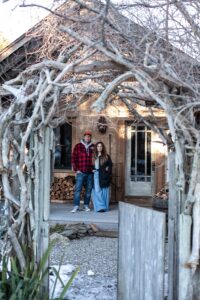
When Jackett first walked into the house that she now shares with McKean, she knew it had potential. “Everyone thought we were crazy when we bought this house,” she says. “It needed a lot of work.” A friend had been living there and maintained an open, spacious floor plan. “It was a big hippie house,” says Jackett. “That’s why I wanted it.” Jackett and McKean have been renovating the home since 2006, guided by a desire to preserve the feeling of that initial encounter.
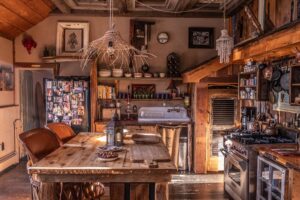
Burdened with mortgage payments, the couple didn’t have much of a budget for renovations or furnishings. But McKean, who is a contractor, was doing remodeling work in Provincetown and kept an eye out for discards and offcuts. “I was the dumpster diver guy,” he says.
Working with found wood, McKean started out with simple projects: a coffee table and then a bed. The massive bed is constructed with large beams and an intricately carved headboard that he found at the swap shop. “It’s a challenge whenever it needs to be moved,” says McKean.
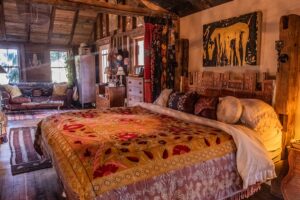
“I love that it’s not perfect,” adds Jackett. “It tells a story of salvaged things.”
Gradually their projects became more ambitious. “I give Nate ideas and he goes to town,” says Jackett. One of her ideas involved found tin, which McKean used to create a coffered ceiling by framing the tin in a tiered wooden grid. Another ceiling was constructed from the subfloor of a home on Montello Street in Provincetown. The thin strips of wood reveal their age through stains, gradients of color, and the occasional rusty nail. McKean makes sure to clip all of the nails, but he doesn’t remove them or heavily sand the wood, preferring to leave traces of its past lives.
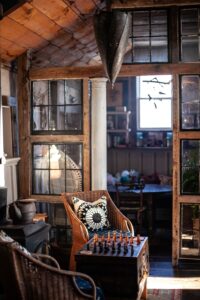
The house, built in 1900, revealed some of its own treasures during the renovation. In one room, McKean removed the sheetrock and was captivated by the wood underneath. Rather than put insulation between the studs and build new walls with sheetrock, McKean left the wood exposed and affixed insulated panels on the outside of the house, over which he attached plywood and shingles. The result leaves the interior feeling beachy and rustic, alluding to the Outer Cape’s dune shacks and summer cottages.
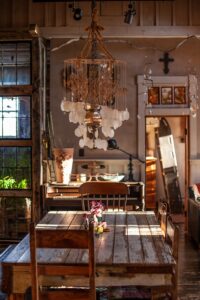
Jackett doesn’t mind their home’s continual evolution. “The house has grown with us, and there’s a piece of us in each stage of the construction,” she says. At first, they divided the house into two spaces: they rented out one half and the other was where Jackett and McKean lived with their three children. Their section of the house was once a barn, evidenced by the high, pitched ceilings. Now that the space is unified, they have the benefit of two kitchens and more space for hosting gatherings.
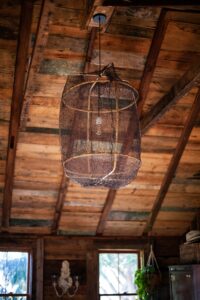
As McKean developed his skills and creativity doing this renovation, the work opened a way for other professional opportunities. For about 10 years he made custom furniture from salvaged and reclaimed wood for clients. Six years ago, he returned to contracting and established McKean Artisan Builders, which specializes in construction projects using reclaimed wood. Renovating the Mary Heaton Vorse house for interior designer Ken Fulk was one of the company’s first jobs.
Fulk wanted the historic Provincetown home to be restored but made to look as if it hadn’t been touched. “We picked the house apart piece by piece and labeled every piece,” says McKean.
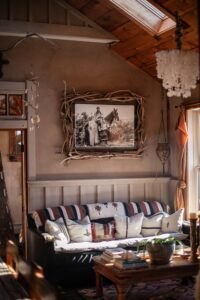
Working on the closet-sized library at the Vorse house, McKean borrowed an idea from his own house. He proposed partitioning off the library using old window sashes from the house. Fulk liked the idea and gave him the green light.
These days, McKean, who supervises a crew of 17 builders, is busy with houses other than his own. But Jackett says that doesn’t mean their renovation project is over.
“I don’t think it will ever be finished,” she says.



